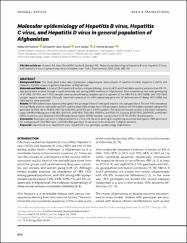| dc.contributor.author | Husseini, Abbas Ali | |
| dc.contributor.author | Saeed, Khwaja Mir Islam | |
| dc.contributor.author | Yurdcu, Esra | |
| dc.contributor.author | Bozdayı, A. Mithat | |
| dc.date.accessioned | 2023-09-20T20:43:40Z | |
| dc.date.available | 2023-09-20T20:43:40Z | |
| dc.date.issued | 2020 | en_US |
| dc.identifier.issn | 2148-5607 | |
| dc.identifier.uri | https://hdl.handle.net/11363/5593 | |
| dc.description.abstract | Background/Aims: This study gives a clue about genotypes, subgenotypes, and subtypes of hepatitis B (HBV), Hepatitis C (HCV), and
Hepatitis D (HDV) viruses in general population of Afghanistan.
Materials and Methods: A total of 234 Hepatitis B surface antigen (HBsAg), 44 anti-HCV, and 5 antidelta positive patients from 25–70-
age group were studied through a rapid screening test among 5898 residents of Afghanistan. After quantifying viral load, genotyping
of 61 HBV, 29 HCV, and 1 HDV samples were accomplished by sequencing of a segment of the HBV Pre S, HCV NS5B, and HDV Delta
antigen regions, respectively. Clinically important variants of the HBV polymerase gene, the “a” determinant of HBsAg, HCV NS5B, and
NS3 regions were assessed.
Results: All HBV isolates were dispersed throughout the genotype D branch and ayw2 was the only subtypes found. The anti-HDV prevalence
among HBsAg-positive individuals was 2.2% and the single HDV sample, from HDV genotype I. Analysis of HCV isolates revealed subtype HCV
genotype 1b (HCV-1b) in 75.86%, HCV-3a in 20.69%, and HCV-3b in 3.44% patients. The observed mutant variants in the major hydrophilic
region (MHR) of HBsAg were Y100 15%, Q101 5%, G102 15%, T115 45%, P120 5%, and T131 5%. Likewise, S213T 10%, Q215P 5%, and N248H
100% mutations were detected in the HBV polymerase region. C316N mutation was prevalent in 72.7% of HCV-1b participants.
Conclusion: Genotypic variation in Afghan patients is in line with the ones existing in neighboring countries and regions. HBV genotypes
D1, subtype ayw2, HDV RNA type I, and HCV RNA genotype 1b are likely to be dominant in Afghan patients. | en_US |
| dc.language.iso | eng | en_US |
| dc.publisher | AVES, BÜYÜKDERE CAD 105-9, MECİDİYEKÖY, ŞİŞLİ, ISTANBUL 34394, TURKEY | en_US |
| dc.relation.isversionof | 10.5152/tjg.2020.19169 | en_US |
| dc.rights | info:eu-repo/semantics/openAccess | en_US |
| dc.rights | Attribution-NonCommercial-NoDerivs 3.0 United States | * |
| dc.rights.uri | http://creativecommons.org/licenses/by-nc-nd/3.0/us/ | * |
| dc.subject | Hepatitis B virus | en_US |
| dc.subject | Hepatitis C virus | en_US |
| dc.subject | Hepatitis D virus | en_US |
| dc.subject | genotype | en_US |
| dc.subject | epidemiology | en_US |
| dc.subject | Afghanistan | en_US |
| dc.title | Molecular epidemiology of Hepatitis B virus, Hepatitis C virus, and Hepatitis D virus in general population of Afghanistan | en_US |
| dc.type | article | en_US |
| dc.relation.ispartof | Turkish Journal of Gastroenterology | en_US |
| dc.department | Sağlık Hizmetleri Meslek Yüksekokulu | en_US |
| dc.authorid | http://orcid.org/0000-0002-8861-7106 | en_US |
| dc.authorid | http://orcid.org/0000-0002-8799-4604 | en_US |
| dc.authorid | http://orcid.org/0000-0002-1441-6408 | en_US |
| dc.identifier.volume | 31 | en_US |
| dc.identifier.issue | 9 | en_US |
| dc.identifier.startpage | 658 | en_US |
| dc.identifier.endpage | 666 | en_US |
| dc.relation.publicationcategory | Makale - Ulusal Hakemli Dergi - Kurum Öğretim Elemanı | en_US |
| dc.contributor.institutionauthor | Husseini, Abbas Ali | |



















